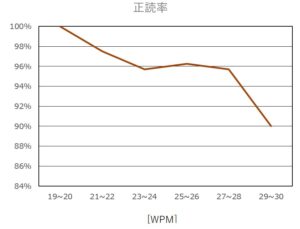In the last KCJ contest in September, I vaguely got the feeling that “it seems that tactile reception is limited to 25WPM. If it goes beyond that, the short dots cannot be counted,” and I decided to measure it properly.
In October, one of the biggest domestic contest is held in Japan. That is “All cities contest”.
I have no interest in winning a prize, so I enjoy setting various personal goals. This year, as part of the “+14db Project,” I decided to experiment with “how fast can tactile reception be?”
In a contest, callsigns and contest numbers are exchanged, and excluding the “599” report that most people send, it usually consists of [4~6 character callsign] + [4~6 city/ward numbers] = about 10 characters. So the callsign and contest number are received by vibration, and if one character is suspicious or cannot be received, it is deducted by 10%, and if two characters are suspicious, it is deducted by 20%, and so on, and the correct reading rate is evaluated for each communication.
The transmission speed of every other party’s Morse code is also measured. The correlation between correct reading rate and speed was as follows: (Note that the sample size was 76 stations from 1.9MHz to 1.2GHz.)

From this table, It can be seen that reception is reliable up to 20 WPM, but at speeds faster than that, an error occurs in about one character out of every 20, and the limit of vibration reception is probably around 28 WPM.
Of course, the signal-to-noise ratio (S/N) also has a big effect on intelligibility, but since the purpose is to find out whether there are a significant number of communication partners even with vibration Morse, I ignored that for the time being. However, it is an interesting topic.
If I continue reception training from my fingertips like this, will my receiving ability exceed 30 WPM?